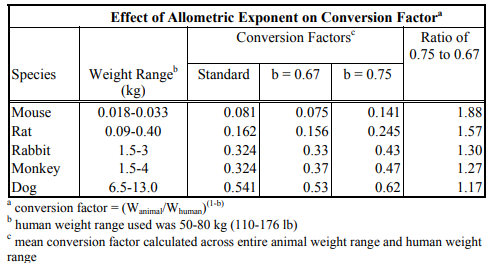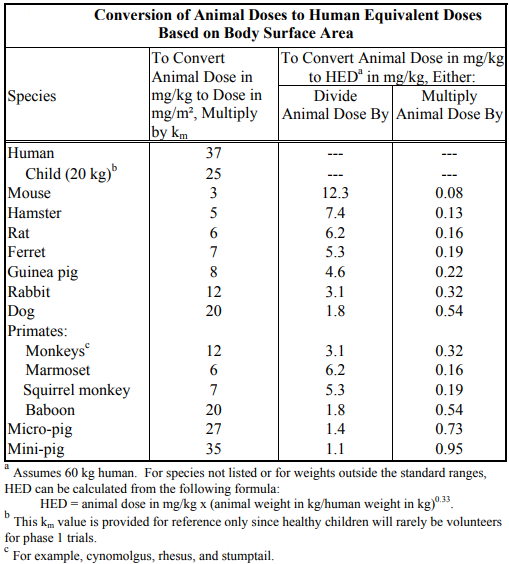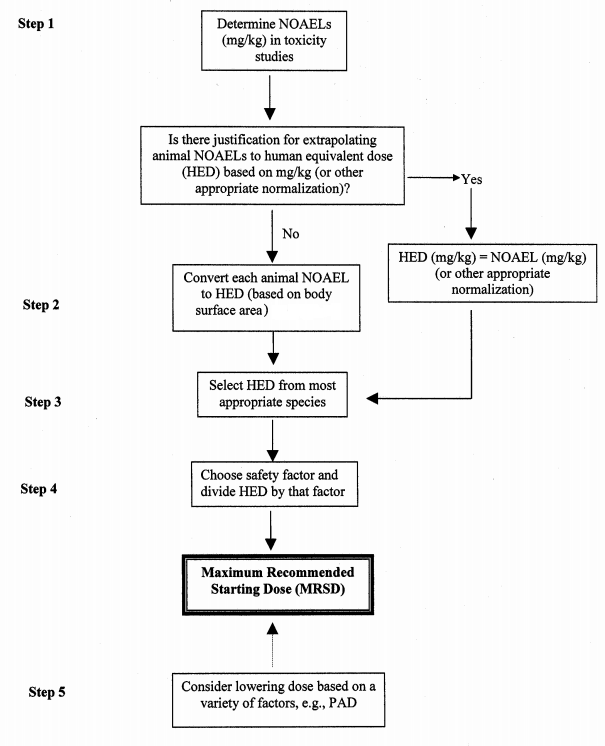What is HED / MRSD and what is it for?
For normal, healthy people, the information set out below is, in principle, only necessary to broaden one's horizons, however, if you have serious health problems that scientists are only trying to effectively treat. Or are you just reckless enough risky and want to achieve quick successes, for example, in sports, or just like to stuff yourself with poorly studied drugs, please, under the cat.
First, it’s worth introducing a few concepts:
Human equivalent dose (HED) is the amount of a substance that a person needs to administer to achieve results similar to those obtained in animal studies.
Maximum recommended starting dose (MRSD) - The recommended maximum starting dose for use in primary human trials. MRSD is not expected to cause side effects in adults and healthy people.
NOAEL (no observed adverse effect level) is the maximum dose at which there is no significant increase in the incidence of side effects or their severity (compared with the control group),
NOEL - the dose at which no effects are detected at all,
LOAEL - the minimum dose causing side effects,
MTD is the maximum dose at which an acceptable level of toxicity is demonstrated.
So what dose of a substance should be taken for a person? The most logical answer is that the dose depends on body weight, but why can't we just take the dose of the animal mg / kg and extrapolate it to the average person?
In some cases, the dose by weight can be calculated, for example, if the NOAEL dose mg / kg is the same for a wide range of species. In most cases, large animals, to which, of course, humans also have a lower metabolic rate, and their physiological processes are slower, i.e. larger animals require a lower dose per weight.
A number of researchers in the mid-20th century, Freireich et al. (1966) and Schein et al. (1970), it was suggested that the dosage should not be reduced to mg / kg, but to mg / m², i.e. not to the mass of the object, but to the surface area of the object.
A few formulas and calculations:
$ inline $ mg / m ^ 2 = k_m × mg / kg $ inline $
Where is the coefficient $ inline $ k_m = 100 / K × W ^ {0.33} $ inline $ where K is a unique value for each species (Freireich et al. 1966) or $ inline $ k_m = 9.09 × W ^ {0.35} $ inline $ where K can already be dispensed with (Boxenbaum and DiLea 1995; Burtles et al. 1995; Stahl 1956).
$ inline $ W = W_ {animal} / W_ {human} $ inline $
$ inline $ HED = animal NOAEL * (W_ {animal} / W_ {human}) ^ {(1-b)} $ inline $
Typically, to reduce the dose to mg / m², the allometric indicator (b) is taken equal to 0.67, but some studies (including data obtained by Freich) show that a coefficient of 0.75 is better suited to calculate MTD, for example, it is the factor that is used in interspecific carcinogenicity studies $ inline $ W ^ {0.75} $ inline $ (EPA 1992). However, to date, there is no data to select the optimal method for converting NOAELs to HEDs. Odds were calculated for a wide range of animal and human weights using
$ inline $ (W_ {animal} / W_ {human}) ^ {0.33} $ inline $
or
$ inline $ (W_ {animal} / W_ {human}) ^ {0.25} $ inline $
to evaluate the effect of these parameters on the choice of initial dosage.

To summarize a little summary:
Today the formula is as follows:
$ inline $ HED (mg / kg = Animal NOAEL mg / kg) × (W_ {animal} / W_ {human}) ^ {(1–0.67)} $ inline $

Examples of independent calculations:
1) From mg / kg to mg / m²
To convert a dose for a person or animal from mg / kg to mg / m², multiply the dose in mg / kg by a factor $ inline $ k_m $ inline $ . Coefficient $ inline $ k_m $ inline $ measured in kg / m² and is equivalent to body weight divided by body surface area.
Formula: mg / kg × $ inline $ k_m $ inline $ = mg / m²
2) Conversion from mg / kg to mg / kg (HED) in two steps
Formula: (animal mg / kg dose × animal $ inline $ k_m $ inline $ ) ÷ human $ inline $ k_m $ inline $ = human mg / kg dose
For example, a dosage of 15mg / kg for a dog: (15 × 20) ÷ 37 = 300 mg / m² ÷ 37 = 8 mg / kg (HED)
3) Convert from mg / kg to mg / kg (HED) in one step
The calculations from the second example can be simplified by combining two steps. HED can be calculated directly by dividing the dose for the animal by the ratio [kmhuman / kmanimal] (third column of the second table) or by multiplying by the inverse ratio (fourth column of the second table).
For example:
Dog-person: 15mg / kg ÷ 1.8 = 8mg / kg (HED)
Rat - Human: 25mg / kg ÷ 6.2 = 4 mg / kg (HED)
Monkey - Human: 50mg / kg ÷ 3.1 = 16mg / kg (HED)
But HED is not the finish point, because, as shown above, this type of dosage can vary greatly from species to species, so how, finally, to calculate the dose for a person?
We take the HED calculated for the most suitable species in each case. In short, it is usually the most suitable species, one for which the calculated HED is minimal, in the example above it is a rat. However, if we dig a little deeper, we will face the fact that there are factors that influence the choice of the species itself: (1) the difference in absorption, distribution in the tissues, metabolism, drug excretion, and (2) hypotheses or previous studies suggesting that a particular the view is most preferred in this case.
A determining aspect for some preparations may be the ability of a particular species to express the corresponding receptors or epitopes. Then, dividing the selected HED by the security factor, we get the MRSD. Historically, the safety factor is 10, but it can be either increased or decreased, depending on the available data.
As an example, take the antiepileptic drug Pregabalin, Pfizer in its MSDS gives the NOAEL dosage for monkeys 100 mg / kg, which translates to 32 mg / kg (HED), or 3.2mg / kg (MRSD). It is noteworthy that the European Medical Agency provides dosages for the first phase of clinical trials in the range of 5-300mg, but I could not find reports in which dosages lower than 25mg were mentioned.
This is what the FDA recommended scheme for determining MRSD in human studies looks like.

Of course, the approach described in this article is far from the only one; there are other methods, including those based on the construction of pharmacological models, but this is a topic for another discussion, which I will try to develop if this material seems interesting to readers.
Literature:
1) A simple practice guide for dose conversion between animals and human
J Basic Clin Pharm. March 2016-May 2016; 7 (2): 27–31.
2) MSDS for Lyrica tablets Pfizer
3) Dose translation between laboratory animals and human in preclinical and clinical phases of drug development.
Drug Dev Res. 2018 Oct 21. doi: 10.1002 / ddr.21461. [Epub ahead of print]
4) www.accessdata.fda.gov/drugsatfda_docs/nda/2005/021724s000_MedR_P2.pdf
First, it’s worth introducing a few concepts:
Human equivalent dose (HED) is the amount of a substance that a person needs to administer to achieve results similar to those obtained in animal studies.
Maximum recommended starting dose (MRSD) - The recommended maximum starting dose for use in primary human trials. MRSD is not expected to cause side effects in adults and healthy people.
NOAEL (no observed adverse effect level) is the maximum dose at which there is no significant increase in the incidence of side effects or their severity (compared with the control group),
NOEL - the dose at which no effects are detected at all,
LOAEL - the minimum dose causing side effects,
MTD is the maximum dose at which an acceptable level of toxicity is demonstrated.
So what dose of a substance should be taken for a person? The most logical answer is that the dose depends on body weight, but why can't we just take the dose of the animal mg / kg and extrapolate it to the average person?
In some cases, the dose by weight can be calculated, for example, if the NOAEL dose mg / kg is the same for a wide range of species. In most cases, large animals, to which, of course, humans also have a lower metabolic rate, and their physiological processes are slower, i.e. larger animals require a lower dose per weight.
A number of researchers in the mid-20th century, Freireich et al. (1966) and Schein et al. (1970), it was suggested that the dosage should not be reduced to mg / kg, but to mg / m², i.e. not to the mass of the object, but to the surface area of the object.
A few formulas and calculations:
$ inline $ mg / m ^ 2 = k_m × mg / kg $ inline $
Where is the coefficient $ inline $ k_m = 100 / K × W ^ {0.33} $ inline $ where K is a unique value for each species (Freireich et al. 1966) or $ inline $ k_m = 9.09 × W ^ {0.35} $ inline $ where K can already be dispensed with (Boxenbaum and DiLea 1995; Burtles et al. 1995; Stahl 1956).
$ inline $ W = W_ {animal} / W_ {human} $ inline $
$ inline $ HED = animal NOAEL * (W_ {animal} / W_ {human}) ^ {(1-b)} $ inline $
Typically, to reduce the dose to mg / m², the allometric indicator (b) is taken equal to 0.67, but some studies (including data obtained by Freich) show that a coefficient of 0.75 is better suited to calculate MTD, for example, it is the factor that is used in interspecific carcinogenicity studies $ inline $ W ^ {0.75} $ inline $ (EPA 1992). However, to date, there is no data to select the optimal method for converting NOAELs to HEDs. Odds were calculated for a wide range of animal and human weights using
$ inline $ (W_ {animal} / W_ {human}) ^ {0.33} $ inline $
or
$ inline $ (W_ {animal} / W_ {human}) ^ {0.25} $ inline $
to evaluate the effect of these parameters on the choice of initial dosage.

To summarize a little summary:
- A change in the allometric indicator from 0.67 to 0.75 has the greatest effect for small species, for example, for mice, the coefficient has changed almost twice.
- The use of indicator b = 0.75 leads to the use of higher, more aggressive and potentially more toxic doses of drugs.
- Limited data show that the use of b = 0.75 is most justified in studies of various anti-cancer drugs.
- Until proven otherwise, the HED will be calculated based on an indicator of b = 0.67
- No noticeable effect of the animal’s body weight on the calculation of HED was observed, within the studied ranges.
Today the formula is as follows:
$ inline $ HED (mg / kg = Animal NOAEL mg / kg) × (W_ {animal} / W_ {human}) ^ {(1–0.67)} $ inline $

Examples of independent calculations:
1) From mg / kg to mg / m²
To convert a dose for a person or animal from mg / kg to mg / m², multiply the dose in mg / kg by a factor $ inline $ k_m $ inline $ . Coefficient $ inline $ k_m $ inline $ measured in kg / m² and is equivalent to body weight divided by body surface area.
Formula: mg / kg × $ inline $ k_m $ inline $ = mg / m²
2) Conversion from mg / kg to mg / kg (HED) in two steps
Formula: (animal mg / kg dose × animal $ inline $ k_m $ inline $ ) ÷ human $ inline $ k_m $ inline $ = human mg / kg dose
For example, a dosage of 15mg / kg for a dog: (15 × 20) ÷ 37 = 300 mg / m² ÷ 37 = 8 mg / kg (HED)
3) Convert from mg / kg to mg / kg (HED) in one step
The calculations from the second example can be simplified by combining two steps. HED can be calculated directly by dividing the dose for the animal by the ratio [kmhuman / kmanimal] (third column of the second table) or by multiplying by the inverse ratio (fourth column of the second table).
For example:
Dog-person: 15mg / kg ÷ 1.8 = 8mg / kg (HED)
Rat - Human: 25mg / kg ÷ 6.2 = 4 mg / kg (HED)
Monkey - Human: 50mg / kg ÷ 3.1 = 16mg / kg (HED)
But HED is not the finish point, because, as shown above, this type of dosage can vary greatly from species to species, so how, finally, to calculate the dose for a person?
We take the HED calculated for the most suitable species in each case. In short, it is usually the most suitable species, one for which the calculated HED is minimal, in the example above it is a rat. However, if we dig a little deeper, we will face the fact that there are factors that influence the choice of the species itself: (1) the difference in absorption, distribution in the tissues, metabolism, drug excretion, and (2) hypotheses or previous studies suggesting that a particular the view is most preferred in this case.
A determining aspect for some preparations may be the ability of a particular species to express the corresponding receptors or epitopes. Then, dividing the selected HED by the security factor, we get the MRSD. Historically, the safety factor is 10, but it can be either increased or decreased, depending on the available data.
As an example, take the antiepileptic drug Pregabalin, Pfizer in its MSDS gives the NOAEL dosage for monkeys 100 mg / kg, which translates to 32 mg / kg (HED), or 3.2mg / kg (MRSD). It is noteworthy that the European Medical Agency provides dosages for the first phase of clinical trials in the range of 5-300mg, but I could not find reports in which dosages lower than 25mg were mentioned.
This is what the FDA recommended scheme for determining MRSD in human studies looks like.

Of course, the approach described in this article is far from the only one; there are other methods, including those based on the construction of pharmacological models, but this is a topic for another discussion, which I will try to develop if this material seems interesting to readers.
Literature:
1) A simple practice guide for dose conversion between animals and human
J Basic Clin Pharm. March 2016-May 2016; 7 (2): 27–31.
2) MSDS for Lyrica tablets Pfizer
3) Dose translation between laboratory animals and human in preclinical and clinical phases of drug development.
Drug Dev Res. 2018 Oct 21. doi: 10.1002 / ddr.21461. [Epub ahead of print]
4) www.accessdata.fda.gov/drugsatfda_docs/nda/2005/021724s000_MedR_P2.pdf
All Articles